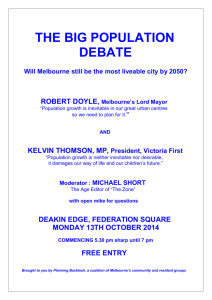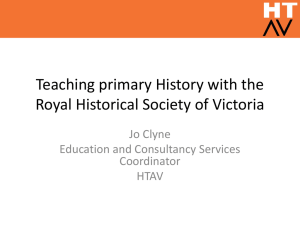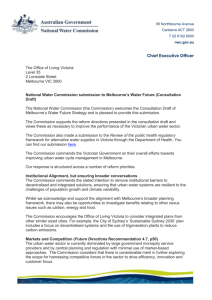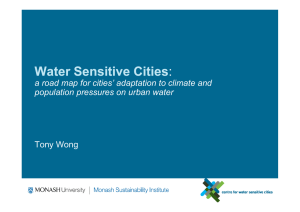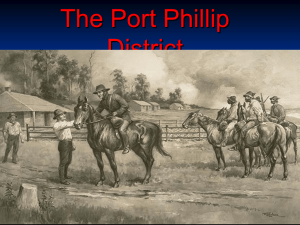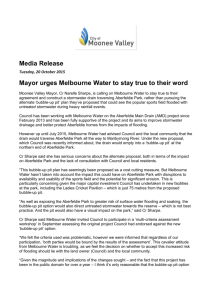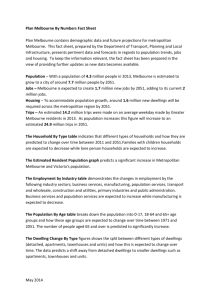green building interface
advertisement
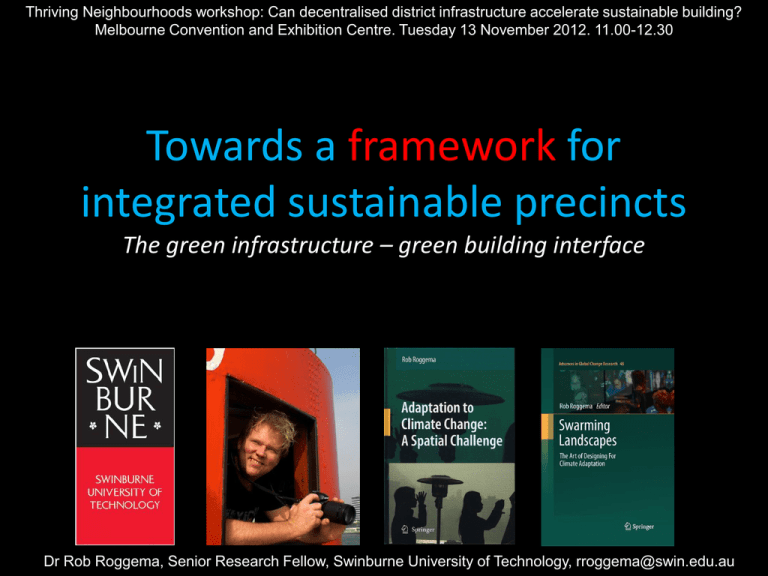
Thriving Neighbourhoods workshop: Can decentralised district infrastructure accelerate sustainable building? Melbourne Convention and Exhibition Centre. Tuesday 13 November 2012. 11.00-12.30 Towards a framework for integrated sustainable precincts The green infrastructure – green building interface Dr Rob Roggema, Senior Research Fellow, Swinburne University of Technology, rroggema@swin.edu.au This workshop is very timely: they want to talk….. • Melbourne Planning Strategy • Hot topics: globally competitive, strong communities, environmental resilience, polycentric linked to regions, 20 minute city, infrastructure, leaderpartner-ship • Today, you are offered the chance to formulate your sustainable contribution! The building envelope Building envelope Maylands activity centre Electricity and gas system Peter Steele? Can we bridge the building with infrastructure and does it deliver sustainable solutions? Objective • creating a framework in which synergies between decentralised infrastructure and buildings enhance sustainability • opportunities and barriers • new and redevelopment precinct scale • decentralised district infrastructure encourage green building? Elements of district infrastructure • • • • • • • • • • • energy (neighbourhood scale) renewable energy, smart grids rainwater harvesting & stormwater storage wastewater reuse green infrastructure (open space, landscape, ecology) recycling and composting, re-use design of public spaces (squares, green space, streets) social infrastructure (education, meeting, networks) public transport/cycling infrastructure … (much more) integrated Output • report • goes to City of Melbourne (presentation), reaction Melbourne let’s talk, part of conference proceedings • academic paper(s) (who wants to join?) Benefit of the workshop • exchange knowledge and ideas • understand how sustainable district infrastructure can be integrated with buildings • acknowledge the infrastructure-building interface as a driver for urban planning Hammarby Sjöstad (SWEDEN): integrated systems, related to the individual building District infrastructure systems: Waste to energy facility for district heating, Wastewater treatment, Central stormwater treatment. The model shows the interaction between sewage and refuse processing and energy provision Sources: http://www.sweden.se/eng/Home/Society/Sustainability/Reading/Facing-the-future/ and http://www.hammarbysjostad.se/inenglish/pdf/Best_env_eng.pdf Vancouver’s Southeast False Creek (CANADA) Neighbourhood Energy Utility (sewer heat recovery system) for space heating and domestic hot water District stormwater treatment Source: https://vancouver.ca/home-property-development/southeast-false-creek.aspx Freiburg: VAUBAN (GERMANY) CHP district heating, Solar, Community waste management, Comprehensive landscaping and urban ecology plan Source: http://www.ced.berkeley.edu/courses/fa10/arch244/?p=1179 WesternHarbour (Västra Hamnen), MALMӦ (SWEDEN) • Integrated waste treatment and combined heat and power (CHP) facilities • Precinct wide renewable energy infrastructure Source: http://www.citiesforpeople.net/cities/westernharbour.html Masdar, Abu Dhabi Solar energy, zerofossil, carbon neutral, car free, zero waste, water-neutral Ecolonia: Alphen a/d Rijn One of the oldest examples: water storage, energy saving, reduced car use, ecology GWL-Amsterdam High density (100/ha, 600 dwellings), CHP, heat exchanger, urban agriculture, car free, water storage and recycling City or building? Zuidkas (the south-greenhouse, Amsterdam Zuidas) a rooftop-based ecosystem that stands to sustain and enrich the structure’s offices, homes, school, and restaurants in addition to a park, a biogas electrical plant and retail facilities (Architectenbureau Paul de Ruiter) Workshop expectations • Six key findings (solutions, strategies, measures) that your group finds to be essential to realise sustainable neighbourhoods. Divide in 3 barriers and 3 opportunities • Provide your contribution to Melbourne Planning Strategy, as an advise, based on your workshop debate and key findings • These advises together we will combine into a framework at the end of the workshop • Every participant is asked to write down his/her two main elements that ‘resonate’ on post-its Use of case study: E-gate Redevelopment: 23 ha, mixed use, residential, commercial, higher densities, close to station, city link, green infrastructure II Building – infrastructure interface Point of Departure Enhancing, framing tools I ‘towards a framework…..’ IteratIve DesIgn Process III Integration, design, Performance tool Program • 4 groups (infrastructure, planning, building, tools) • 11.10 Brainstorm, collect solutions, strategies and measures, select six key findings (3+3) • 12.00 report back (4x5 minutes) • 12.20 building of framework • 12.30 end (continue the discussion over lunch) • Each group to appoint one reporter/presenter and note-taker
